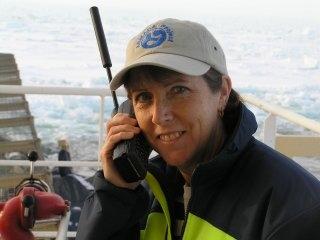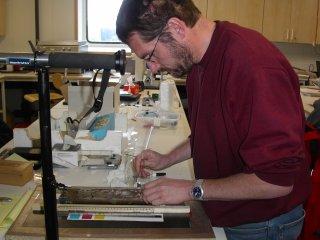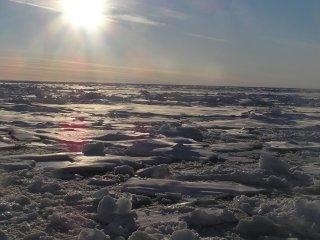2 September, 2004
Summer in the Arctic - Present and Past
It is official - the school year has started at Narragansett Pier Middle
School and I am still on summer vacation. Today was the first staff day back
at school, technically a Professional Development Day. I suppose I could
really look at each day that I have been here on the ACEX expedition as part
of my own professional development program. I am really back in the role of
student as I learn more each day from the scientists aboard the Oden. I am
learning new concepts in micropaleontology and geology and expanding my
knowledge in disciplines more familiar to me such as microbiology. All the
same, I felt the need to connect with my colleagues at school so I used my
Iridium satellite phone to call the school at a time I expected that they
would be breaking for lunch. I called a bit too soon but did get to speak to
Jo-Ann in the office and my Red Team-mate, Pat Boynton. I could envision the
NPS teachers in the workshop, tanned and in summer clothing while I stood on
the helideck in my fleece and Gore-Tex in a dusting of new fallen snow. By
the time I finished the call my gloved hands were so cold I could hardly
push the button to end the call. So this is summer?
It sure hasn't felt like summer here lately, but we are finding evidence
that the Arctic was not always this ice-covered and cold.
Erik and I continue to spend some of our days, talking to the various
scientists on board and videotaping them discussing their backgrounds and
expertise. I was especially keen to talk to Henk Brinkhuis, from Utrecht
University, about his work. Henk enthusiastically explained his work to us
in a way that so clearly shows the excitement of scientific discovery. He
has recently identified microfossils of the spores of a fresh-water fern
called Azolla; this plant is known more commonly as duckweed. What this
means is that the Arctic Ocean was at some point a fresh-water body, a lake
or part of a series of lakes!
What an experience for me to look at these ancient spores! As I gaze through
the microscope I imagine my students and hope they will be just as excited -
it is like looking back at a dinosaur.
Other observations from the expedition suggest the idea that this place on
top of the world was once a much warmer place than today - that surface
ocean temperatures were subtropical and close to 200C (680F). How can an
observation like this be made? Henk and his fellow dino-specialist, Jens
Matthiessen from the Alfred Wegener Institute, have uncovered evidence that
would lead to this idea; they have found in the sediments the presence of a
subtropical species of dinoflagellate (a one-celled microorganism), one
certainly not associated with Arctic conditions. There is much more
scientific evaluation that must take place before this is substantiated, but
the implications for Arctic climate history are just amazing.

Calling the Narragansett Pier Middle School on an Iridium satellite phone

Jens Matthiessen examining sediments in the Oden main lab

A summer day in the Arctic 2004
Contact the TEA in the field at
.
If you cannot connect through your browser, copy the
TEA's e-mail address in the "To:" line of
your favorite e-mail package.
|
